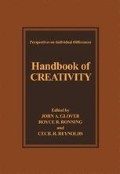Abstract
I was invited by the editors of this volume to write a chapter on “creativity and the self.” Given the vague and slippery nature of these concepts, this is not an easy task—attempting to be heuristic in my creative thinking about creativity. I shall first define creativity and selfhood, then relate creativity to several person variables and psychological processes. I will then critique the literature and offer some suggestions for a new program of research. Last, I will discuss various ways of fostering creativity in people.
Access this chapter
Tax calculation will be finalised at checkout
Purchases are for personal use only
Preview
Unable to display preview. Download preview PDF.
References
Amabile, T. M. (1982). Children’s artistic creativity: Detrimental effects of competition in a field setting. Personality and Social Psychology Bulletin, 8, 573–578.
Amabile, T. M. (1985). Motivation and creativity: Effects of motivational orientation on creative writers. Journal of Personality and Social Psychology, 48, 393–397.
Bamber, R. T., Jose, P. E., and Boice, R. (1975). Creativity as affected by differential reinforcements and test instructions. Bulletin of the Psychonomic Society, 6, 361–363.
Bolen, L. M., and Torrance, E. P. (1978). The influence on creative thinking of locus of control, cooperation, and sex. Journal of Clinical Psychology, 34, 903–907.
Bowers, K. S. (1976). Hypnosis for the seriously curious. New York: Norton.
Cohen, S., and Oden, S. (1974). An examination of creativity and locus of control in children. Journal of Genetic Psychology, 124, 179–185.
Damm, V. J. (1970). Creativity and intelligence: Research implications for equal emphasis in high school. Exceptional Children, 36, 565–569.
Dellas, M. (1978). Creative personality and identity. Psychological Reports, 43, 1103–1110.
Dowd, E. T. (1984). Leisure counseling with adults across the life span. In E. T. Dowd (Ed.), Leisure counseling: Concepts and applications (pp. 214–233 ). Springfield, IL: Charles C Thomas.
Dowd, E. T., and Milne, C. R. (1986). Paradoxical interventions in counseling psychology. The Counseling Psychologist, 14, 237–282.
DuCette, J., Wolk, S., and Friedman, S. (1972). Locus of control and creativity in black and white children. Journal of Social Psychology, 88, 297–298.
Felker, D. W., and Treffinger, D. J. (1971, February). Self concept, divergent thinking abilities, and attitudes about creativity and problem solving. Paper presented at the American Educational Research Association convention, New York.
Glover, J. A., and Sautter, F. (1976). An investigation of the relationship of four components of creativity to locus of control. Social Behavior and Personality, 4, 257–260.
Guidano, V., and Liotti, G. (1982). Cognitive therapy and emotional disorders. New York: Guilford Press.
Guidano, V. F. (1987). Complexity of the self. A developmental approach to psychopathology and therapy. New York: Guilford Press.
Holland, J. L., and Nichols, R. C. (1964). The development and validation of an indecision scale: The natural history of a problem in basic research. Journal of Counseling Psychology, 11, 27–34.
Iso-Ahola, S. E. (1984). Social psychological foundations of leisure and resultant implications for leisure counseling. In E. T. Dowd (Ed.), Leisure counseling: Concepts and applications (pp. 97–125). Springfield, IL: Charles C Thomas.
Jaquish, G. A., and Ripple, R. E. (1981). Cognitive creative abilities and self-esteem across the adult life span. Human Development, 24, 110–119.
Koestner, R., Ryan, R. M., Bemieri, F., and Holt, K. (1984). Setting limits on children’s behavior: The differential effects of controlling vs. informational styles on intrinsic motivation and creativity. Journal of Personality, 52, 233–248.
Kroger, W. S. (1977). Clinical and experimental hypnosis ( 2nd ed. ). Philadelphia: J. B. Lippincott.
MacKinnon, D. W. (1964, March). Identification and development of creative abilities. Paper presented at the conference on Creativity and the Mentally Gifted, Fresno, CA.
Mathes, E. W. (1978). Self-actualization, metavalues, and creativity. Psychological Reports, 43, 215–222.
McDowell, C. F. (1984). Leisure: Consciousness, well-being, and counseling. In E. T. Dowd (Ed.), Leisure counseling: Concepts and applications (pp. 5–51). Springfield, IL: Charles C Thomas.
Meichenbaum, D. (1975). Enhancing creativity by modifying what subjects say to themselves. American Educational Research Journal, 12, 129–145.
Murphy, J. P., Dauw, D. C., Horton, R. E., and Fredian, A. J. (1976). Self-actualization and creativity. Journal of Creative Behavior, 10, 39–44.
Nabi, K. S. (1979). Personality and self: The creativity discussion. Indian Psychological Review, 18, 5–8.
Richmond, B. O., and de la Sema, M. (1980). Creativity and locus of control among Mexican college students. Psychological Reports, 46, 979–983.
Rogers, C. R. (1959). A theory of therapy, personality, and interpersonal relations, as developed in the client-centered framework. In S. Koch (Ed.), Psychology: A study of science, Vol. 3 (pp. 184–256 ). New York: McGraw-Hill.
Schaeffer, C. E., Diggins, D. R., and Millman, H. L. (1976). Intercorrelations among measures of creativity, openness to experience, and sensation-seeking in a college sample. College Student Journal, 10, 332–339.
Schempp, P. G., Cheffers, J. T., and Zaichowsky, L. D. (1983). Influence of decision making on attitudes, creativity, motor skills, and self-concept in elementary children. Research Quarterly for Exercise and Sport, 54, 183–189.
Schubert, D. S., and Biondi, A. M. (1977). Creativity and mental health: III. Creativity and adjustment. Journal of Creative Behavior, 11, 186–197.
Sisk, D. (1972). Relationship between self-concept and creativity: Theory into practice. Gifted Child Quarterly, 16, 229–234.
Torrance, E. P. (1971). Identity: The gifted child’s major problem. Gifted Child Quarterly, 15, 147–155.
Whiteside, M. (1977). Self-concept differences among high and low creative college students. Journal of College Student Personnel, 18, 224–227.
Williams, A. J Poole, M. E., and Lett, W. R. (1977). The creativity/self-concept relationship reviewed: An Australian longitudinal perspective. Australian Psychologist, 12,313317.
Wright, R. J., Fox, M., and Noppe, L. (1975). The interrelationship of creativity, self-esteem, and creative self-concept. Psychology, 12, 11–15.
Author information
Authors and Affiliations
Editor information
Editors and Affiliations
Rights and permissions
Copyright information
© 1989 Springer Science+Business Media New York
About this chapter
Cite this chapter
Dowd, E.T. (1989). The Self and Creativity. In: Glover, J.A., Ronning, R.R., Reynolds, C.R. (eds) Handbook of Creativity. Perspectives on Individual Differences. Springer, Boston, MA. https://doi.org/10.1007/978-1-4757-5356-1_14
Download citation
DOI: https://doi.org/10.1007/978-1-4757-5356-1_14
Publisher Name: Springer, Boston, MA
Print ISBN: 978-1-4419-3212-9
Online ISBN: 978-1-4757-5356-1
eBook Packages: Springer Book Archive

